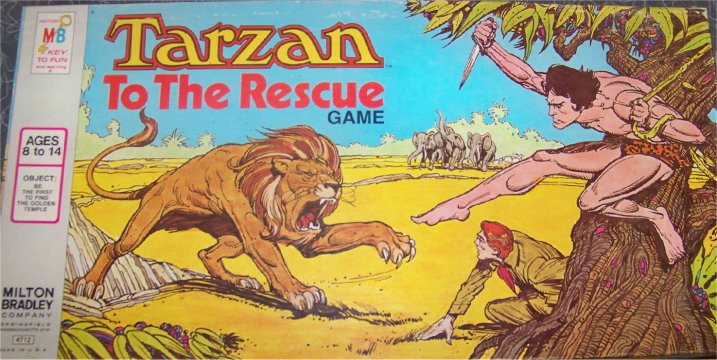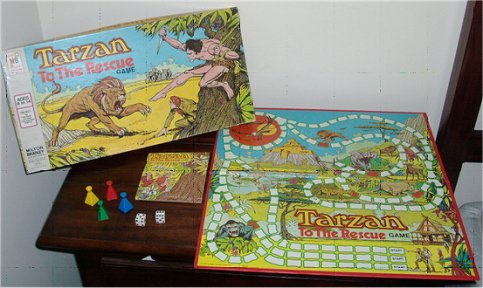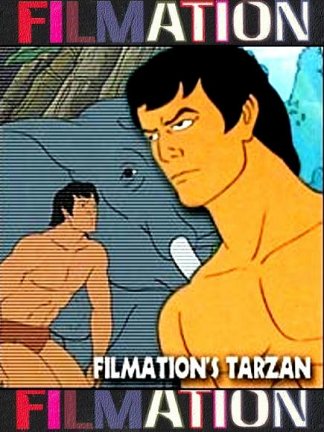There is a legend that is whispered by the natives,
that rising from the plains beyond the great jungles, a golden temple appears.
Could this legend be true? A group of scientists hoping to find the answer
start their long trek, each trying to be the first to arrive at the Golden
Temple. Many times they will become side-tracked and their cause will seem
hopeless. They call on Tarzan to come to the rescue when their path is
blocked.
OBJECT: Be the first to find the Golden Temple.
1. Each player chooses a pawn of his color, and each player
rolls the dice. High dice goes first and starts on a path in any lane he
wishes. Others follow in turn clockwise.
(Comment: There are only three starting lanes, yet the
game is for up to four players. I guess this means you don't put your pawns
down until you've rolled the dice for your first turn, and then you count
the starting block as square one. The rule says "each player chooses a
pawn of his color." Maybe that means that you have to be a Thark to choose
the green pawn and a red Martian or Apache to choose the red one, and so
on. Perhaps a flesh-colored pawn is needed for the rest of us!)
2. Each player in turn must follow this sequence.
(a) First move your pawn along the path for the full
count of EITHER one of the dice. Pawns cannot be moved backward.
(b) Second, move any opponent's pawn for the count of
the other dice. You may, if it is to your advantage, use either the high
or low count of the dice, but you must move your own pawn first.
3. (a) You may move your pawn ONE lane to the right or
left to an empty space, during any part of your dice count, to pass another
player or gain a path advantage.
(b) You may not change lanes
more than once during the same turn. (Your own pawn may change a lane and
the opponent's pawn, you move, may change a lane in one turn.)
NOTE: Try to move your pawn
into the clear path and your opponent's pawn into the dangerous side paths.
4. A player may not pass a red space on the path without
calling for Tarzan. You may call for Tarzan on your next turn.
5. (a) TO CALL FOR TARZAN: Open cover on Tarzan spinner.
Spin the disc and wait for spinner to stop. Close the cover. If all white
shows through the opening on the front cover of the spinner, Tarzan can
not help you in this turn. Any color showing Tarzan helps you.
(Comment: My spinner’s background color is yellow, not
white. If any part of the Tarzan design or surrounding foliage is visible,
I consider that to be “Tarzan.”
(b) If Tarzan does not help you,
you must wait until your next turn and call for Tarzan again.
(Comment: This might be a bit too strict and frustrating
for small children. When I play it with young people, we just spin once
to see if Tarzan will help. If he doesn’t, then that particular turn is
lost, but the player goes ahead and rolls the dice on the next turn without
having to call for Tarzan again.)
6. If you are blocked by another player ahead on any path
and you cannot use the full count of one dice, you cannot move. You must,
however, move an opponent's pawn for the count of one dice.
(COMMENT: There are going to be times when it is impossible
to move the opponent's pawn, too. For instance, if your opponent is sitting
on a red square, he is not allowed to move until Tarzan rescues him...so
how can you move him? The opponent on the red square might also be blocking
an opponent behind him. The rules do not say whether or not one piece can
"jump" another piece. It would seem that, in order for the game to flow
properly, you would have to be able to jump an opponent, but you could
not occupy the same space as an opponent. That's the way I play it!)
7. You may take the danger path at any time by your own
choice, if you find the way blocked and trust Tarzan can help you.
8. The first player at the Golden Temple by exact count
wins the game.
(Comment: It doesn't say whether the last white square
counts as the Golden Temple, or whether the temple itself represents the
"last square." So, your choice!).



![]()


![]()

![]()
